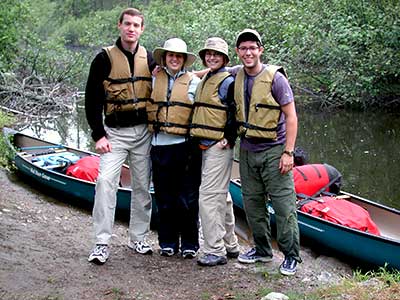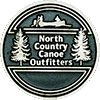What to Bring on Your Canoe Trip
This is a question we often get from prospective clients. So here is our best advice on what to bring on your canoe trip, broken down into the following topics:
Camping Equipment – Food – Clothing and Personal Items – Checklist of Personal and Group Items to Bring
 Camping equipment and food
Camping equipment and food
Equipment
Most of our visitors leave this entire effort to us as we are professionally equipped to provide the finest canoes and camping equipment. This equipment is specifically designed for use here in the north country. Much of today’s “high tech” backpacking equipment is not suited to canoe travel. And, conversely, canoe camping equipment tends to be single-purpose gear, ideal for canoeing but not well-suited for other types of camping.
Even well equipped Scout troops leave their own gear at home and avail themselves of the convenience of using North Country’s equipment. But should you have most of your own gear, we would suggest following (and limiting) your selections to what we would be providing with our complete outfitting packages.
Food
We have a selection of 45 great tasting meals that are nutritious and easy to prepare. Our fresh food offerings are the largest in the area, and we are the only outfitter in the world licensed as part of the American Angus Association. In return, we have certified that every cut of beef we serve is a genuine Certified Angus Beef steak!
But should you be packing your own food, you must follow a very important federal wilderness regulation:
- Nothing may be packaged in a glass bottle or a metal can.
That means NOTHING! No Spam cans. No Dinty Moore Beef Stew cans. No Campbell’s Soup cans. No Coke cans. No beer cans. It means no fruit juice bottles. No peanut butter or jelly jars. No Pepsi bottles. - The only exceptions to the can and bottle ban are:
- Fuel may be in a can or a metal bottle.
- Medicine may be in a bottle.
- Insect repellent may be in a can or bottle.
- Personal hygiene products such as deodorant or shaving cream may be in a can or bottle.
- There are NO other exceptions! But there are federal fines for folks who decide to make their own exceptions.
We would strongly urge you to NOT bring a cooler with the intention of keeping fresh foods cold out on the canoe trails. The ice will melt after the first day, and then you will still have to lug the cooler over every portage for the rest of the trip. (We have forbidden our staff from laughing at any one who insists on taking a cooler, but we have caught them chuckling a little in private.)
If you want to bring meat, plan on having it the first day. Arrive at our base with it frozen, or purchase it locally at Zup’s Grocery as you drive through town. We can store it for you overnight in one of our freezers, and it will thaw while you are traveling the first day on the canoe trails.
We would also strongly urge you to NOT carry soft drinks in plastic bottles. They are actually very heavy in your pack, and you must carry out the empties. Plastic bottles may not be burned in Minnesota. Instead, mix up some instant drinks such as Kool-aid, Gator-aid, or Instant Breakfast (make sure the ingredients list powdered milk).
As for adult beverages, we would steer you away from beer. Like soft drinks, beer gets very heavy in any quantity to be worthwhile. But, if you must have your malt & hops, it, too, must be packaged in plastic bottles. Miller has beer in plastic, and Bass Ale also comes in plastic. These two items can be purchased at several liquor stores here in Ely as you drive through town.
If you take our recommendation on not carrying beer, but still want to have-a-sip after a long day of pushing water, many vodkas, gins, bourbons, and scotch come in plastic. We must admit that a little J&B Scotch, mixed with a little cold water from Bald Eagle Lake, can be a special treat after paddling all day with a friend (in this case, the owner of a competing – and second best – outfitting business)!
Clothing and Personal Items
The following list represents our suggestions as to what personally supplied items should be taken on a 6-day, completely outfitted, trip in midsummer. If your trip is in May or September, or a different length, make the necessary adjustments for cooler temperatures. Take personal preferences into consideration. As you pack, continually remind yourself of the following:
- Most people take “too much stuff” on their trips.
- You will be in a wilderness. Comfortable and rugged means far more than style.
- You have chosen one of the few outfitters that exclusively provides ultra-lightweight equipment. Don’t make your personal pack ultra-heavy.
What to Bring Checklist
Personal Items |
|
|---|---|
| Quantity | Item |
| 2 | Pair of rugged long pants. In our estimation jeans are fine, BUT they can be chilling when wet and do take a long time to dry. |
| 1 | Additional pair of long pants or shorts |
| 3-6 | Changes of underwear and heavy cotton or wool socks (personal preference on count) |
| 3 | Medium or heavyweight cotton shirts (T-shirts are fine) |
| 1 | Heavyweight wool or flannel shirt |
| 1 | Lightweight jacket or windbreaker (heavier jackets in May or September) |
| 1 | Pair of rugged shoes (climbing boots are too heavy – sandals and aqua socks are too light) |
| 1 | Pair of tall waterproof boots (for stepping into cold lake water in May or September) |
| 1 | Pair of tennis or jogging shoes for camp wear (the other pair will get wet on every portage) |
| 1 | Inexpensive rain suit (they often get torn). For safety reasons, a poncho should be avoided! |
| 1 | Swimsuit (optional, however, on remote lakes) |
| 1 | Drink bottle or canteen: 1 quart size. (Also available in our shop.) |
| 1 | Toilet kit: 2 towels, soap, toothbrush, personal items, medications (allergies), glasses, small personal kit with a few Band-Aids & adhesive tape, sunglasses, sun block, etc. |
| 1 | Large stuff sack or pillowcase to pack the above items in, AND 2 large heavyweight trash bags (as personal pack liners). Normally two (sometimes three) people share one personal pack. The stuff sacks serve as personal dividers; the trash bags ensure the items stay dry. |
Shared Group Items |
|
| 1 | Compass |
| 1 | Bic-type lighter should you loose your matches or they get wet. |
| 1 | Needle nosed pliers with wire cutters. If anyone plans to fish, bring at least one additional. |
| 1 | Compact group first aid kit with antiseptics, wound management supplies, eye wash, tweezers, pain medication, antiseptics, anti-inflammatory, intestinal medications, etc. |
Optional Items, but strongly recommended |
|
| 1 | Cotton or leather work gloves |
| 1 | Pocket knife (not a sheath knife for your belt) |
| 1 | Small flashlight |
| 1 | Camera & lots of film |
| 1 | Book to read or deck of cards |
| 1 | Separate set of clean clothes for the trip home |
Basic Fishing Gear |
|
| RODS | We suggest ONE rod & reel per person, with one spare per every two people. Fresh line for the trip (6-8# for spinning, 8-12# for casting). |
| THE BASICS |
Do not bring a large tackle box. A two sided 7″X9″X4″ box per person or a tray-type 9″X14″X8′ for two people is about right. Two or three lures of each type and shade will cover average needs. Tackle should include BOTH light and dark shades, because Quetico and BWCA have both light and dark lakes. As a general rule of thumb, Quetico trips tend toward the lighter shades: chrome, silver, white, yellow, silver & black, silver & blue, and chartreuse. BWCA trips tend toward darker colors: black, brown, dark green, gold, and yellow. |
| LURES | NORTHERN PIKE: 9″ / 25# wire leaders, mid- to large size (1/2 – 1 oz) spoons and diving plugs, spinners for spring and fall trips.WALLEYE: Feather or hair 1/8 – 1/4 oz. jigs, small 1/8 -1/4 oz sinking plugs and spinners, floating jigs for live bait (leeches).SMALLMOUTH BASS: Shallow to medium running floating plugs and smaller spinners for spring and fall, top-water plugs & poppers for midsummer. Deep diving plugs and medium sized spinners for mid-day fishing. Ball or stand-up jigs in the 1/4 – 3/8 oz. size work well for live bait (leeches or crawlers).LAKE TROUT: In spring and fall use smallmouth gear. In summer use northern pike tackle without the wire leaders.PAN FISH: We suggest 1/16 -3/16 oz. feather or hair jigs, or with live bait. Small minnow type in-line spinners work well. |
| JUST TALKIN’ TACKLE |
We carry the above basic items in our shop if you can’t find them at home.For specific lures on specific lakes, we recommend finishing out your selections in our small tackle shop after the mapping session. We can then talk about your individual situations.Don’t load up on a lot of recommendations from a local store at home. Their “tips” are usually too general for the unique lakes of the canoe country. If the salesman swears it works, have a little fun. Ask “On which specific lakes?” Then watch his expression change. |
